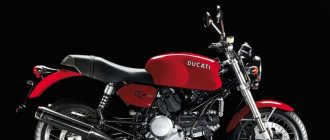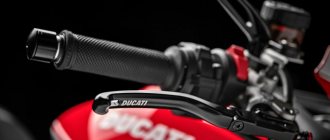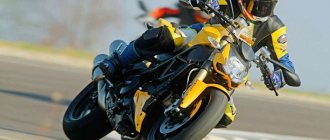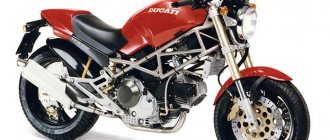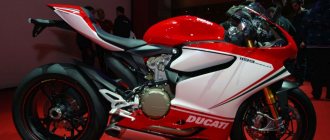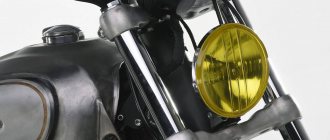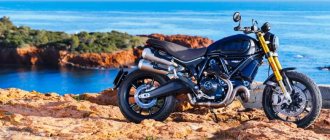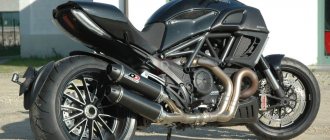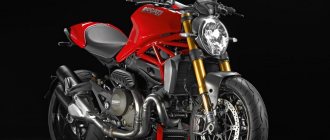Ducati SS1000: Redesign of SportClassic GT1000
Like any normal cult motorcycle, the Ducati SportClassic was fairly underrated in its time. That's probably because it was so ahead of its time, combining retro styling with modern performance years before it became mainstream. Or perhaps its design just didn't fit into the mainstream of design thought - most articles talk about it as timeless and elegant, but some call it strange and unwieldy.
Greaser Garage
Something like this, apparently, was spinning in the heads of the guys from Greaser Garage, in Genoa in northern Italy. They really like the GT1000's underpinnings and its potential, which is "hidden beneath a bulky body that's heavy and unsightly."
Greaser Garage founder Giorgio Pellegrino has been riding bikes since he was 15 years old. He opened this workshop, as they say, “to support his pants” 10 years ago, and then things went so that he works there full time, along with five permanent employees and two part-time employees.
Such a team can do almost anything within the walls of the workshop - which means they can take on Ducati.
The GT1000 is built on a damn flexible base, says Giorgio, on which many other aerial vehicles from the Borgo Panigale (historical district in the city of Bologna) are built.
Ducati SS1000
Remove the tank and ugly seat and you're left with a good old tubular steel frame, a cool twin-cylinder engine and not much else except a huge plastic airbox.
Greaser Garage wanted to do something completely unusual on the same basis, and their customer had one important request: to keep the motorcycle as pragmatic in use as possible - in the sense that they should not unnecessarily tinker with the engine or play with the injector - and This meant that the giant airbox could not be touched.
Ducati GT1000 Touring
The search for a motorcycle to replace the stolen GS is in full swing.
There's a new semi-finalist and it's Ducati. To be honest, initially I was looking at the Multistrada, because it formally plays in the same class as the GS, namely adventure touring bikes. The achievements of Gary Egan spoke in favor of Multik (as Russian Ducatists call Multistrad). In 2004, he drove DMS-1100 from Prudhoe Bay (northwestern edge of Alaska) to Key West (southeastern edge of Florida), that is, he cut the continent diagonally in 101 hours, thereby improving the record that had stood for many years by 13 hours. My toad also liked the Multistrada, of course - a run-free motorcycle from 2009 costs as much as a used three-year-old GS, and if you take the 2008, then for the same money you can get the “S” version with Olins all around.
The notorious Italian quality spoke against Multik. Either they equip the car with tires from three different manufacturers, or the knob of the gearbox lever falls off. And if the Italians allow themselves to do this with the legendary Alfas, where is the guarantee that the equally legendary Ducatis are made better?
To find out, I raided the dealer's showroom. I reported the results at the BMW Club conference, there is nothing special to add. And in that salon there was a Ducati GT1000 Touring, which I fell in love with at first sight.
The motorcycle is amazingly beautiful, both in photographs and in hardware. A huge (25 cm in diameter) headlight with a characteristic “antique” diffuser pattern, a round brake light, chrome-plated headlights, fenders and a very stylish trunk, glass of the correct “collective farm” shape, and finally - spoked wheels. The first thought is what happens to him if he is fed well. Well, I just lost a quarter of a century naturally, where are my 17 years? And this despite the fact that the technical filling is quite modern. A thoughtful inspection and conversation with a friendly seller helped determine that the motorcycle is equipped with the same desmodromic engine as on the Multistrada-1100, a thick (43 mm) Marzocchi upside-down at the front, 320 mm brake discs, and Sachs rear shock absorbers have a single spring preload adjustment.
Of course, I tried on the motorcycle. The bike doesn’t look big, but you feel like you’re sitting quite high, with a slight tilt forward (I wonder how the tilt will affect a long journey). Moreover, the feeling is exactly Izhevsk, you seem to be sitting “on” and not “in” a motorcycle. The device in general and the tank in particular are very narrow, the knees are moved unusually close. The seat is quite comfortable, although to confirm this you probably need to burn at least a couple of tanks in a row, but “who’s going to give it to him.” However, if you want more comfort, you can order a special touring saddle.
Here I would like to say this. We all love our motorcycles and definitely change them somehow to suit ourselves. Who will hang the exhaust louder, who will install nitros, who will order airbrushing, or at least buy a sticker for the tank. So, the GT1000 is ideally suited for this purpose, it provokes an upgrade. Right in the cabin, I wanted to put on it those old-fashioned mirrors that are screwed in instead of steering wheel weights. And of course, hang the trunks, where would we be without them? Moreover, standard plastic GIVI-style suitcases clearly do not fit into the image. “Are there branded ones?” - I ask the seller. "Certainly!" - he says. The announced price and delivery time convinced me that the word “humanism” is not in the vocabulary of Ducati marketers, but . So, having visited the company’s website, I discovered that the catalog of accessories for this model takes 7 pages and there is everything there - from weights on the steering wheel and stickers on the tank, to an oversized steering wheel and sprockets for selecting the final drive. Just pay the money. There are also mirrors as I wanted.
By the way, Touring was produced only in 2009 and has already been discontinued this year. What to do if dealer stocks of last year's devices run out? Actually, it's no big deal. The factory Touring version differs from the regular GT1000 by having glass already installed, chrome fenders and a luggage rack from the list of accessories. That is, on the one hand, you won’t have to pay extra for them. On the other hand, the standard GT1000 can be upgraded to Touring.
We continue our online investigation. The motorcycle was created by the famous Pierre Terblanche, he actually did a lot of good things at Ducati, and now works for the Piaggio group. He was inspired, of course, not by the products of the Izhevsk Motor Plant, but by the 1971 Ducati GT750, the first civilian motorcycle in the company’s history with a two-cylinder V-shaped engine, which many call L-shaped due to the right angle of the cylinder camber. Retro specificity is generally a very subtle thing, but BMW and MINI did it well, but Volkswagen and the Beetle, not so much. Terblanche, I think, did an excellent job. I even reproduced the authentic logo of those times.
By the way, he himself set himself the task of creating a weekend motorcycle for 50-year-old men nostalgic for their two-wheeled youth. Judging by how his work captivated me, the designer coped with the task.
So, what are the pros and cons noted by the experts who tested the GT1000.
Pros:
— dense suspension, especially the front one, provides excellent handling and acceptable comfort.
— informative brakes, never overheat.
- Excellent gearbox, gears shift like clockwork.
- behaves perfectly in turns, deep leans are easy, and in right turns the motorcycle traces the asphalt with the brake foot, and in left turns - with the exhaust pipe passing under the engine.
— a high fan factor is noted by all testers.
Minuses:
— no traction at the bottom, the engine wakes up after 3500 rpm,
— and even a tight clutch, that is, it will be sour in traffic jams.
— slippery saddle with a slight tilt forward, as a result you always slide onto the tank
— the gears are too long, 3750 rpm in 6th gear = 110 km/ (well, I don’t know, in my opinion this is just a plus for touring, but when overtaking you can go a couple of steps lower. — Frank)
— the characteristic pulsating recoil of the V2 makes maneuvering at low speed very difficult (some kind of nonsense, maybe the tester just needed to get used to it? — Frank)
— at night the light is rather weak, you need to install a light bulb with greater efficiency
And finally, the most important issue is quality. The service interval of modern Ducati motorcycles is 12,000 km, which is above average. True, evil tongues say that the interval has been increased to compensate for the expensive cost of maintenance and there are no technological improvements behind this. Luckily, the tireless testers at WebBikeWorld maintain a blog where they describe the life of the purchased GT1000. A thoughtful reading of the blog showed that there are problems, but overall it’s not that bad. However, judge for yourself.
1. The 2007 models had problems with the fuel line, Ducati carried out an official free replacement of the problem parts.
2. It was possible to loosen the nut securing the wheel axle in order to tighten the chain only with
.
3. The frames of branded cases are cracking.
4. The plastic gas tank becomes wider over time and comes out of the brackets that secure it to the front. As a result, the tank is held on by a single bolt at the rear. The situation is potentially very dangerous. Ducati considers the case under warranty and replaces the tank without questions, but, according to the dealer, with exactly the same one. That is, the problem is not actually solved, but postponed. The final solution is a few washers on the brackets.
5. They also rust. Some people buy nickel-plated knitting needles. The guys from WBW found a simple way out of the situation - they bought themselves golden wheels. See for yourself what happened, although I love the gypsy look, even for me the look is too elegant.
Well, the Italians also make you happy with little things. Someone will order chrome fenders, the front will fit, but the rear will not. Then they will go to change the light bulb in the headlight, the instructions say that there is one screw, but there are two. And so on. In general, on the one hand, the motorcycle will not let you get bored, on the other hand, the simple design makes it possible to play the instrument yourself in the garage.
So, we have a beautiful, unusual, well-handling bike with charisma and a name for the price of some boring Japanese neoclassic. In short, I think strongly.
Ducati motorcycles
Ducati is a famous Italian manufacturer of sportbikes and all-terrain motorcycles with an L-shaped engine. The company was founded in 1926 in Bologna. At first, Ducati produced radio equipment, but the factories were destroyed during the Second World War and after it the company began producing engines for motorcycles.
By the end of the 50s, the company successfully competed in motorcycle racing with the powerful Ducati 250 Twin motorcycle. A feature of most Ducati V-twin engines is that the angle between the cylinders is 90 degrees, and one of them is parallel to the ground. This served as the basis for the name of the line of engines - L-shaped.
In addition to the unusual engine, Ducati motorcycles had another feature - the “desmodromic” valve system. This design was developed by engineer Fabio Taglioni, and, largely thanks to it, the company successfully competed in sports competitions. A special feature of this system is the use of a cam drive for the valves. The industry of that time could not provide the required quality of springs for closing valves at high speeds, and the new “desmodromic” system allowed Ducati motorcycles not only to increase efficiency and engine life at high speeds, but also to increase torque at the bottom.
In the 60s and 70s, Ducati continued to compete successfully in racing, improving its sports motorcycles. It was in the 70s that L-Twin engines gained sports fame and became widespread among “civilian” motorcycles.
In 1983, Ducati was acquired by the Castiglioni family and the company merged with the Cagiva group. At this time, Ducati sportbikes continue to be improved and the first model from the Ducati Monstr line of universal motorcycles, which is still popular today, is released.
In the mid-90s, Ducati changed ownership again - the company was acquired by the Texas Pacific investment group. Ducati sports bikes actively and successfully compete in the prestigious World Superbike series.
Success in the World Superbike series pushed Ducati to participate in the MotoGP World Championship. For this purpose, a Ducati Desmosedici GP motorcycle with a V-shaped four-cylinder engine was specially released. In 2007, Ducati wins the MotoGP World Championship.
Now Ducati continues to adhere to the principle of “win a race today, sell a bike tomorrow”, spending about 10% of its budget on sports. Thanks to this spending, the company has a very strong position in sportbikes, superbikes and road bikes. The company is also actively developing enduro motorcycles and cruisers, trying to gain a foothold in new market segments.
